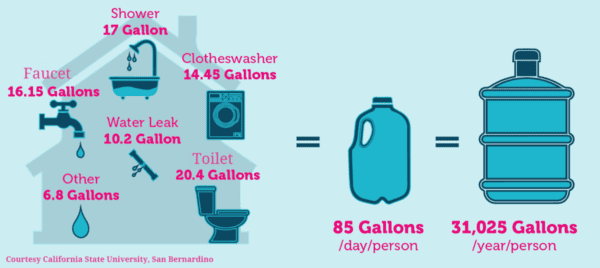

The California State Water Board held a hearing last week to discuss how to implement Senate Bill 1157, passed by the legislature in 2022, which lowers daily indoor water use standards to just 47 gallons per person starting in 2025 and 42 gallons in 2030. The title of the hearing was “Making Water Conservation a Way of Life,” but rationing would be a more apt description of what’s coming for California’s households.
It isn’t as if conservation hasn’t been a way of life in California for decades. Despite the state’s population growing to over 39 million today, total urban water consumption in the state has been falling each year since the mid-1990s. At just over 7 million acre feet per year in 2022, urban water consumption hasn’t been this low since 1985, when the population of the state was only 26 million.
Yet, California’s water bureaucrats continue to steamroll ahead with SB 1157. The officially stated goal is to reduce total urban consumption by 400,000 acre feet per year by 2030. Put into the perspective of California’s total water withdrawals per year, this is very small potatoes.
Water diversions for agriculture average 30 million acre feet per year, more than four times the urban use, and diversions — captured rainfall that is released from reservoirs during the summer and fall — to maintain ecosystem health range between 20 million acre feet in dry years to over 60 million acre feet in wet years.
A 400,000 acre foot reduction in urban water consumption represents barely more than one-half of one percent of the amount of water California diverts and manages even in its driest years.
So what will Californians be asked to do to meet SB 1157’s targets?
Imagine having to report how many people live in your home in order to qualify for your 42 gallon per person per day water allocation.
Imagine having to justify your “outdoor water budget” in order to keep your outdoor landscaping healthy.
Imagine having to decide what you are going to have to give up — showering, laundry, washing dishes or flushing your toilet — to stay under the 42 gallon cap each day.
How We Use Water


But guess what? This kind of extreme water rationing is completely unnecessary. Cost-effective supply-side solutions are plentiful.
In the water season that just ended in California, over 25 million acre feet of water passed through the Sacramento-San Joaquin Delta and out to the Pacific. This is more than twice what is required for the health of Delta ecosystems, and if that water had been stored, it would have offered enough supplemental supply to easily withstand several years of drought.
There are many ways to store this water that fulfill reasonable environmentalist concerns. For example, channels cut into Delta islands can have gravity-fed French Drains that move water without harming fish. Engineering studies indicate that a 200 acre site could move 15,000 acre feet per day during storms, and this water could be stored in vacant underground aquifers that are, just in the San Joaquin Valley, estimated to have a capacity of 75 million acre feet.
Other ways to realize massive increases in urban water supplies were described in detail last year in a study released by the prestigious Pacific Institute. They estimated that just through capturing urban runoff, up to 3 million acre feet could be stored each year, and that by recycling urban waste water, capturing another 2 million acre feet per year is possible. Even if these figures are optimistic, they accurately identify two additional paths to water abundance that are necessary investments anyway.
Harvesting rainfall through daylighting streams and diversions into aquifers will prevent flooding and will help mitigate toxic runoff from urban surfaces. Recycling and reusing urban wastewater will eliminate the nitrogen pollution still present in treated outfall. And what also ought to be on the table to increase water supply are additional reservoirs as well as desalination.
There are plenty of ways to achieve water abundance in California.
Water rationing will not achieve the resilience that Californians are going to need in the future, whether it’s to adapt to prolonged droughts and bomb cyclones, or to cope with other potential disruptions to the state’s precarious network of pipelines, pumping stations and aqueducts. Precisely the opposite policy should be California’s legislative priority.
Water agencies need to be incentivized to increase their supply capacity, not reduce it to a fragile minimum that lacks any margin for error. At what point will California lawmakers abandon scarcity fearmongering and instead pursue common sense strategies to secure water abundance?
The 47 gallon per person indoor water use standard is set to begin in 2025 and the 42 gallon limit only 5 years later.
How will you allocate your 42 gallons a day?
Today’s newsletter is based in part on the latest edition of “What’s Current?” — a weekly newsletter by CPC senior fellow Edward Ring, author of “The Abundance Choice: Our Fight for More Water in California.” To keep up with the latest California news on water, energy and environmental regulation, sign up now for “What’s Current?”
Plus, visit AbundanceCA.com to learn more about Californians for Energy and Water Abundance, a project of California Policy Center.



